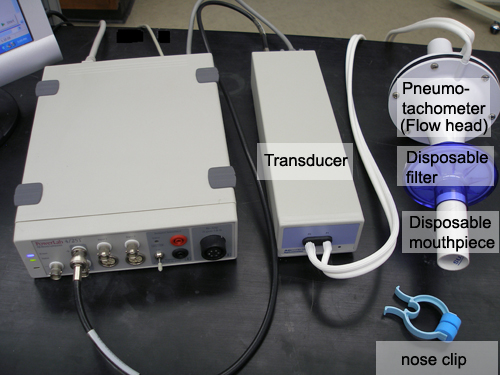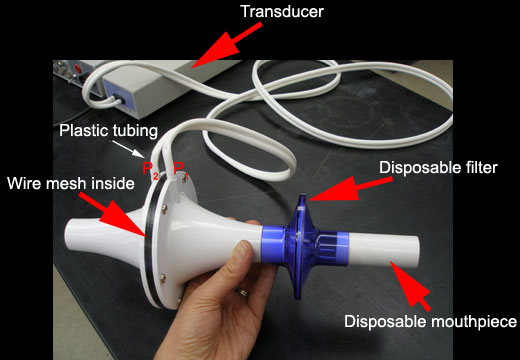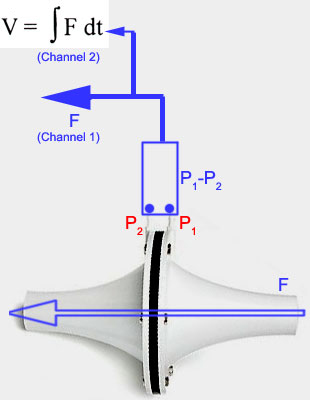|
Respiration
Laboratory |
Pneumotachometry>
Recording airflow |
| |
Many important aspects
of lung function can be determined by measuring airflow and the
corresponding changes in lung volume. Airflow can be measured directly
with a pneumotachometer and a
transducer. |
A pneumotachometer converts the flow of
gases through it into a proportional signal of pressure difference on
either side of a central mesh whose design ensures a signal linearity
over a range of flow rates with a minimum dead space.
|
|
|
|
|
The setup will consist of a flow head
(pneumotachometer) and a transducer which will integrate volume from
flow. |
 |
|
The flow head |
|
 |
|
In this type of
pneumotachometer, flow is derived from the pressure
difference over a small, fixed resistance, offered by a fine metal mesh
inside the plastic cone. The trumpet-like shape of the pneumotachometer
is designed to achieve laminar flow over a wide range of flows (up to 12
L/sec). (When high flows give rise to a turbulent flow pattern, the
pressure drop across the resistance would change more than
proportionally with flow). Two small plastic tubes attached on
either side of the mesh transmit the pressure difference across the mesh
to the differential pressure transducer.
The transducer converts the
pressure signal into a changing voltage that is recorded by the PowerLab
and displayed with the Chart software. The volume, V, is then calculated
as the integral of flow:

This integration
represents a summation over time; the volume traces that you will see in
the Chart View during the experiment are obtained by adding successive
sampled values of the flow signal and scaling the sum appropriately.
The integral is initialized to zero every time a recording is started.
|
 |
|
The difference in the temperature of the
ambient air and the air exhaled during expiration must be considered in
accurate measurements of tidal volume. Since the volume of gases depends
on temperature, recorded tidal volume has to be corrected accordingly.
Correction must be used to convert flow and volume measured at ambient
conditions to the conditions within the lungs. The ambient conditions
are called ATPS (Ambient Temperature and Pressure,
Saturated with water vapour). The conditions within the lungs
are called BTPS (Body Temperature and Pressure,
Saturated). |
|
Conditions affecting pneumotachometry |
|
|
The volumetric accuracy of pneumotachometry
is primarily dependent on the flow condition. Day-to-day
variation in ambient temperature and thus pneumotachometer temperature
will affect pneumotachometer sensitivity as a result of change in gas
viscosity. Moisture accumulation in the flow head, and non-ideal
distribution of air flow across the wire mesh, may result in a drift in
the zero setting. This component of drift is minimized by the use of
disposable droplet filters. |
|
To continue to the next section:
Experiments, click here |